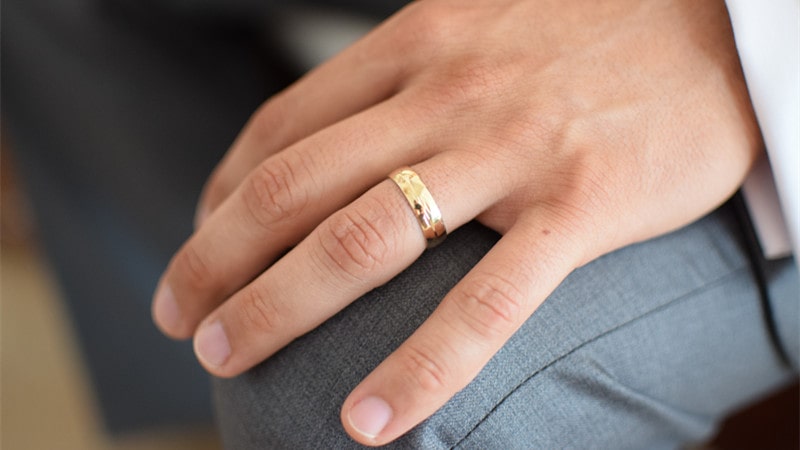The statement that “the wedding bands are a symbol of love and commitment between couples” is undoubtedly fair and true, but as every word or phrase that is continuously repeated it has almost lost its meaning. It has become just a flat delivery of our respectful attitude towards this jewelry piece, frequently expressed in a rather emotionless way.
We’re about to emphasize the importance of understanding and what is even more crucial, actually feeling the true value of a wedding band and what it symbolizes. Let’s start with the history of this significant jewelry piece.
The Evolution of Wedding bands
The tradition of wearing a ring to signify marriage, as expected, has no precise date or even a year. It dates back to Ancient Egypt, where the circular shape of the ring was believed to represent eternity and the unbroken bond of marriage.
And by the ‘unbroken bond’ and ‘eternity’ they really meant that “till death parts us” doesn’t work here, as there’s a belief that the wives of Egyptian pharaohs were buried alive with their deceased husband. True or not, but it adds weight to their attitude towards the strength of marriage bonds.
In ancient Rome, wedding rings were made of iron and were worn only by women. The ring was more of a declaration of ownership, than a beautiful symbol of eternal love made of precious materials. The ring was given by the husband to his wife as a sign that the woman is off the market.
It wasn’t until the 2nd century AD that men began to wear wedding rings as well, and, what a coincidence, the accessories were now made of more valuable materials such as gold and silver.
In medieval Europe the Christian church played a significant role in the development of the wedding ring tradition. The church declared that marriage was a sacrament, and the exchange of rings during the wedding ceremony became a common practice. The rings were blessed by the priest and were seen as a symbol of the couple’s bond with each other and God.
Over time, the design of wedding rings evolved. In the 16th and 17th centuries, rings with elaborate engravings and gemstones became popular among the wealthy. However, it wasn’t until the 20th century that the simple, classic design of the plain gold band became the standard for wedding rings.
Today, wedding bands are worn by couples all over the world, and they come in a variety of styles, designs and materials. From traditional gold bands to diamond-studded rings, the wedding ring remains ‘a symbol of love and commitment’ between two people.
The Best Metals for Wedding Bands
As wedding bands are often worn every day and are expected to last a lifetime, the choice of materials for these items is an important decision that should be carefully considered. Some of the most popular materials used for wedding bands include gold, platinum, titanium, and tungsten. Each of these metals has unique characteristics and benefits, making them suitable for different preferences and lifestyles.
Gold is the most traditional material for wedding bands and comes in a variety of colors, including yellow, white, and rose. It is a classic and timeless choice that can be easily customized with different designs and engravings. Gold is a relatively soft metal and can become scratched over time, but it can be easily repaired and maintained.
Besides, scratches are not always a bad thing, they make a precious reminder of all the hardships you’ve successfully overcome with your beloved partner. But if you prefer your wedding ring as good and shiny as new, the skillful jeweler will easily help you.
Platinum is a more durable and dense metal than gold, making it an excellent choice for those who are rough on their jewelry. It has a silvery-white color that won’t fade or tarnish, making it a low-maintenance option.
Contemporary platinum wedding bands for men represent the edgy jewelry items that are able to elevate the style of a modern man along with being a meaningful reminder of his feelings. Platinum is also hypoallergenic, as well as gold, making those metals a great choice for those with sensitive skin.
Titanium is a lightweight, durable metal that is resistant to scratches and corrosion. It has a contemporary look and is available in a range of colors, including black and gray. Titanium is also hypoallergenic, so it won’t be a problem for people with sensitive skin to wear a wedding band made of titanium every day.
Tungsten is an extremely durable metal that is scratch-resistant and will not tarnish or fade over time. It has a unique, gunmetal-gray color and a modern, industrial look. Tungsten is hypoallergenic and affordable, making it a popular choice for those who want a stylish and durable wedding band without breaking the bank.
After all, the material you choose for your wedding band will depend on your personal style, budget, lifestyle and comfort. Whether you prefer a classic gold band or a modern tungsten ring, there is a material out there that is perfect for you.
Diamonds and Other Gems in the Wedding Bands
For centuries, precious gems have been used to enhance the beauty and significance of wedding bands. Among these gems, diamonds are the most popular choice, but other precious and semi-precious stones can also add charm and personality to a wedding band.
Diamonds are valued for their exceptional brilliance, hardness, and durability, which make them a perfect symbol of lasting love. They are often set in various styles, such as solitaire, pave, or halo, to showcase their fire and sparkle. This Men’s Diamond Wedding Band is a bright example of an elegant piece of jewelry, that tells a lot about its wearer.
First, it makes a statement that the man is confident about his choices, both in life and jewelry; second, it declares that its owner knows a thing or two about style; third, the man is proud and willing to share his joy of having the best wife on the planet by showcasing the flashy symbol of their love to the public. Such a wedding band is a great combination of symbolism and flawless taste.
In men’s diamond jewelry the most common diamond shapes for wedding bands are round, princess, cushion, and emerald, while other fancy shapes like oval, pear, marquise, and heart are eagerly used to create a unique and personalized design for women’s wedding bands.
Besides diamonds, other gemstones that are frequently used in wedding rings include sapphires, rubies, and emeralds, which are known as the “big three” of colored gemstones. These gems are valued for their rich colors, durability, and rarity, and they can add a touch of royalty and sophistication to a wedding band. With the recent tendency for colorful jewelry, the wedding bands featuring these flashy gemstones look extremely fresh and edgy.
Sapphires, for instance, come in various shades of blue, pink, yellow, and purple, and they are often associated with loyalty, wisdom, and serenity. Rubies, on the other hand, are known for their deep red hue, which symbolizes passion, courage, and vitality. Emeralds, meanwhile, are valued for their lush green color, representing growth, prosperity, and harmony.
If you’re looking for a special symbolism that can be understood only by you and your partner, there’s plenty of precious and semi-precious stones that will provide for you this opportunity. The gems that can be used in wedding bands include aquamarines, amethysts, topazes, garnets, tourmalines, and many more.
Each of these gems has its own unique beauty, meaning, and symbolism, and they can be combined with diamonds or other stones to create a stunning and meaningful wedding band. For example, a birthstone or a gem that represents a couple’s shared interests or values can be incorporated into the design to add a personal touch and a deeper connection.
It is not as crucial what the wedding band means for the majority of people, the most important is what it is to you. Even the materials of you wedding band are not as vital as the feelings of you and your beloved one that fill this jewelry. As long as you remember the love story your wedding band is supposed to tell, such words as ‘love’ and ‘commitment’ won’t sound empty and cliché to you.




